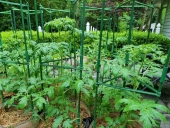
 8
8




Zone 6, 45 inches precipitation, hard clay soil




 1
1




Bless your Family,
Mike
 3
3




 2
2




Zone 6, 45 inches precipitation, hard clay soil




 3
3




![Filename: tomato-flower-sucker-pattern-(2).jpg
Description: [Thumbnail for tomato-flower-sucker-pattern-(2).jpg]](/t/178560/a/182204/tomato-flower-sucker-pattern-(2).jpg)
Zone 6, 45 inches precipitation, hard clay soil




 6
6




Zone 6, 45 inches precipitation, hard clay soil




 3
3




 2
2




Zone 6, 45 inches precipitation, hard clay soil




 4
4




Jen Swanson wrote:One trick to get your tomatoes to ripen before frost hits is to prune off the top growth, including flowers that have not yet started to be fruit, one month before frost is expected. This forces the plant's energy into ripening the fruit that is on the plant. I've also had good luck with cutting down my tomatoes just before frost and hanging them upside down in the garage. It is really amazing how long they keep and continue to ripen!
Zone 6, 45 inches precipitation, hard clay soil




 3
3




Zone 6, 45 inches precipitation, hard clay soil




 3
3




Zone 6, 45 inches precipitation, hard clay soil





|
Fire me boy! Cool, soothing, shameless self promotion:
Learn Permaculture through a little hard work
https://wheaton-labs.com/bootcamp
|




